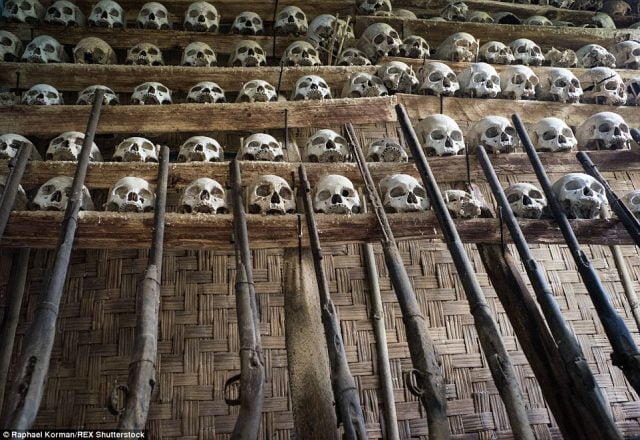By Aatreyee Dhar
Demystifier: An ED Original where we take a complex topic but the content is written in such a way that it is knowledgeable and easy to comprehend at the same time.
The ancient practice of ‘headhunting’ embraces preserving of a person’s head after killing him. In the Indian subcontinent, headhunting persisted among the Naga tribes of Konyaks in the North-East up to the 20th century.
Caught in the far-flung forests between Myanmar and India, the village of Longwa is home to India’s last generation of headhunters. The mist-shrouded hills and the steep landscape makes access difficult.
The fierce Konyak Naga tribes are the largest of 16 tribes thriving in the Indian state of Nagaland. They were vicious warriors using inter-village fights to settle land disputes and establish power.
With no qualms about taking the heads of their victims, the Konyaks focused on their deep-rooted beliefs. They believed that a human skull contains the power for the life force behind the prosperity of their crops, clans, and animals. Occasional capture of a human skull was necessary even for marriage apart from killing their enemies.

After the young boys had passed the rite of passage of severing the heads of their enemies, they showed off their hunted heads by their topknots. The women served them rice wine. The skulls were prominently displayed on a flat stone outside the hunter’s house after the hair and flesh had been boiled off. Success was rewarded with the imprint of tattoos on the face and chest.
The hereditary chieftain of the tribe, called “Angh” took care of the administration. The Anghs practiced polygamy and had several wives. Rice is the staple food and is stored in huge bamboo containers. The Konyak huts are made of bamboo. They are spacious with separate partitions for cooking, dining, sleeping, and storage.
Resisting Governance for Years
The ancestors of the Konyaks are believed to be migrants from either Mongolia or southern China. With no broad tribal identity, they mingled as Nagas to the outsiders for the past two centuries.
Their villages are situated on ridge tops to monitor and identify any enemy attack. Choosing to stay isolated, local languages and customs were nurtured. Headhunting formed the root of their culture that was too strong to be shaken.
Failing to subdue the Nagas for the past 50 years, the British empire left them sitting or standing on the fence that divides both the countries with the international border passing through Longwa. The Nagas owed no allegiance to either India or Burma.
Also read: This Cult Thought God Is An Alien And Death Would Help You Reach Outer Space To Meet Him
When Christianity brought in Civilisation
With the arrival of the Christian missionaries in the 19th century, their traditions were threatened. American Baptist, Edwin A. Clark, opened a missionary school training the Nagas and converting them. By the late 20th century, the beating of drums and dancing were silenced by the wave of American music comprising of gospels and hymns. More than 90 percent of the population stood converted, ready to plunge them into the modern world.
Although the Baptists unified them with messages of peace and the common bond of language, their culture was ripped apart by an acute identity crisis. Skulls were burned and traditional relics were destroyed.
The Absolute End to their Tradition
The Nagas were united and granted independence ahead of the day India was granted hers. Headhunting came to an end in the 1960s.
The National Socialist Council of Nagaland (NSCN) is an insurgent group operating in Nagaland. They have their camps sprawling around the Church headquarters of Dimapur and are the sole negotiators with the Indian Government.
Their demand for a sovereign state has been met with stringent actions and counterattacks from the Indian Army. But their activities have sparked resentment with them trying to control everything from household taxes to import tariffs.
Conflicts among tribal factions were raging. With the factions splintered, they turned against one another.
The Nagaland state government’s 10-day Hornbill festival is held every December. Praised for its flamboyant display of Naga heritage and former Headhunters, thousands of tourists pour into these remote areas.
Waves of Modernism have swept across the state with bamboo huts replaced by concrete floors and tin roofs. One can find them talking about their traditions and the heads they decorated once in their community halls. They mourn in peace, letting out their resentment through songs. Songs that speak of their lost traditions and a disheartening end to their race.
You don’t need to fear about losing your heads now! They are the last and we shall see them no more.
All Images Credits: Google Images
Sources: BBC, National Geographic
More on ED Times:
Demystified: The History And Purpose Of The Orange-Clad Kanwariyas
DEvil: Indians In The UK Are Easy Prey For Babas, Tantriks And Charlatans